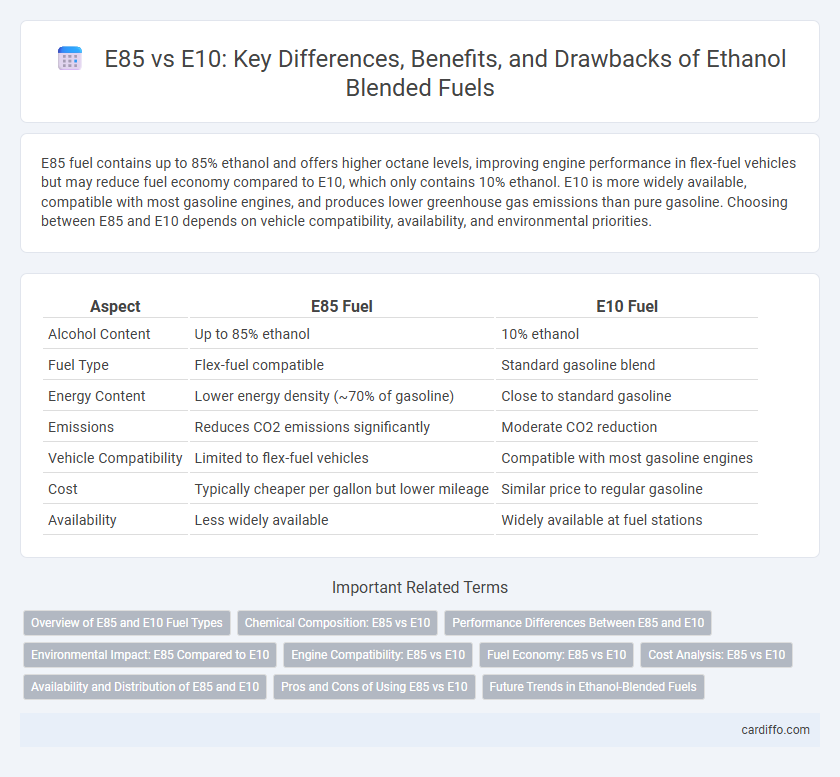E85 fuel contains up to 85% ethanol and offers higher octane levels, improving engine performance in flex-fuel vehicles but may reduce fuel economy compared to E10, which only contains 10% ethanol. E10 is more widely available, compatible with most gasoline engines, and produces lower greenhouse gas emissions than pure gasoline. Choosing between E85 and E10 depends on vehicle compatibility, availability, and environmental priorities.
Table of Comparison
| Aspect | E85 Fuel | E10 Fuel |
|---|---|---|
| Alcohol Content | Up to 85% ethanol | 10% ethanol |
| Fuel Type | Flex-fuel compatible | Standard gasoline blend |
| Energy Content | Lower energy density (~70% of gasoline) | Close to standard gasoline |
| Emissions | Reduces CO2 emissions significantly | Moderate CO2 reduction |
| Vehicle Compatibility | Limited to flex-fuel vehicles | Compatible with most gasoline engines |
| Cost | Typically cheaper per gallon but lower mileage | Similar price to regular gasoline |
| Availability | Less widely available | Widely available at fuel stations |
Overview of E85 and E10 Fuel Types
E85 fuel consists of 85% ethanol and 15% gasoline, offering higher octane levels and reduced greenhouse gas emissions compared to traditional fuels. E10 contains 10% ethanol and 90% gasoline, providing better compatibility with most vehicles and improved fuel economy over pure gasoline. Both fuel types contribute to renewable energy use, but E85 is primarily used in flexible-fuel vehicles designed to handle higher ethanol concentrations.
Chemical Composition: E85 vs E10
E85 is a fuel blend containing up to 85% ethanol and 15% gasoline, whereas E10 consists of 10% ethanol and 90% gasoline. The higher ethanol content in E85 significantly increases its oxygen content, leading to cleaner combustion and fewer carbon emissions compared to E10. This difference in chemical composition affects energy density, with E85 having a lower energy content per gallon than E10, influencing vehicle fuel efficiency and performance.
Performance Differences Between E85 and E10
E85 fuel, containing up to 85% ethanol, generally offers higher octane ratings around 100-105 compared to E10's typical 87-93, enabling improved engine performance and greater resistance to knocking. Vehicles optimized for E85 can achieve increased horsepower and torque due to the fuel's higher octane and cooling properties, but may experience lower fuel economy because of ethanol's lower energy density. E10, with only 10% ethanol, provides greater fuel efficiency and compatibility with a wider range of vehicles while still reducing emissions compared to pure gasoline.
Environmental Impact: E85 Compared to E10
E85 fuel, consisting of 85% ethanol and 15% gasoline, significantly reduces greenhouse gas emissions compared to E10, which contains only 10% ethanol. The higher ethanol content in E85 lowers carbon monoxide and particulate matter emissions due to ethanol's cleaner combustion properties. However, E85's overall environmental benefit depends on sustainable ethanol production methods and regional vehicle compatibility.
Engine Compatibility: E85 vs E10
E85, comprising up to 85% ethanol, requires flex-fuel vehicles specifically designed to handle higher alcohol content without damaging engine components, whereas E10, containing only 10% ethanol, is compatible with most gasoline engines without modification. Engines running on E85 benefit from cooler combustion temperatures and higher octane levels but need specialized fuel system materials and engine calibration to prevent corrosion and ensure optimal performance. E10's extensive compatibility with standard engines makes it a widely accepted fuel blend, offering moderate emissions reductions and improved octane without the need for flex-fuel technology.
Fuel Economy: E85 vs E10
E85 contains up to 85% ethanol, which has a lower energy content per gallon compared to E10's 10% ethanol blend, resulting in approximately 25-30% reduced fuel economy. Vehicles optimized for E85 may experience increased fuel consumption despite its higher octane rating. E10 offers better mileage per gallon and greater availability at fueling stations, making it more economical for drivers prioritizing fuel efficiency.
Cost Analysis: E85 vs E10
E85 fuel typically costs less per gallon than E10 due to its higher ethanol content, which is generally cheaper than gasoline. However, vehicles running on E85 experience lower fuel economy, with efficiency dropping by approximately 25-30% compared to E10, affecting overall cost-effectiveness. Considering both price per gallon and reduced miles per gallon, E10 often results in lower fuel expenses for daily driving despite a higher initial cost.
Availability and Distribution of E85 and E10
E10, containing 10% ethanol, is widely available across most fuel stations in the United States and Europe, benefiting from established infrastructure and regulatory support. E85, a higher concentration fuel with 85% ethanol, has limited distribution primarily in regions with a strong demand for flex-fuel vehicles, such as the Midwest in the U.S., due to specialized storage and dispensing requirements. The broader availability of E10 ensures easier access for conventional vehicles, while E85's distribution remains niche, targeting specific markets with ethanol-compatible engines.
Pros and Cons of Using E85 vs E10
E85 fuel contains up to 85% ethanol, offering higher octane and reduced greenhouse gas emissions but can reduce fuel economy and may not be compatible with all vehicles. E10, with 10% ethanol, provides better engine compatibility and fuel efficiency but offers lower renewable content and fewer emissions benefits compared to E85. Choosing between E85 and E10 depends on vehicle specifications, fuel availability, and balance between environmental benefits and fuel economy.
Future Trends in Ethanol-Blended Fuels
E85 and E10 ethanol blends represent significant milestones in renewable fuel adoption, with E85 containing up to 85% ethanol and E10 comprising 10% ethanol mixed with gasoline. Future trends indicate a growing emphasis on higher ethanol blends like E85 to reduce greenhouse gas emissions and enhance energy security, supported by advances in flex-fuel vehicle technology and government incentives. The shift toward sustainable biofuels is expected to accelerate as infrastructure expands and engine compatibility improves, positioning ethanol blends as key components in the transition to cleaner transportation fuels.
E85 vs E10 Infographic

 cardiffo.com
cardiffo.com